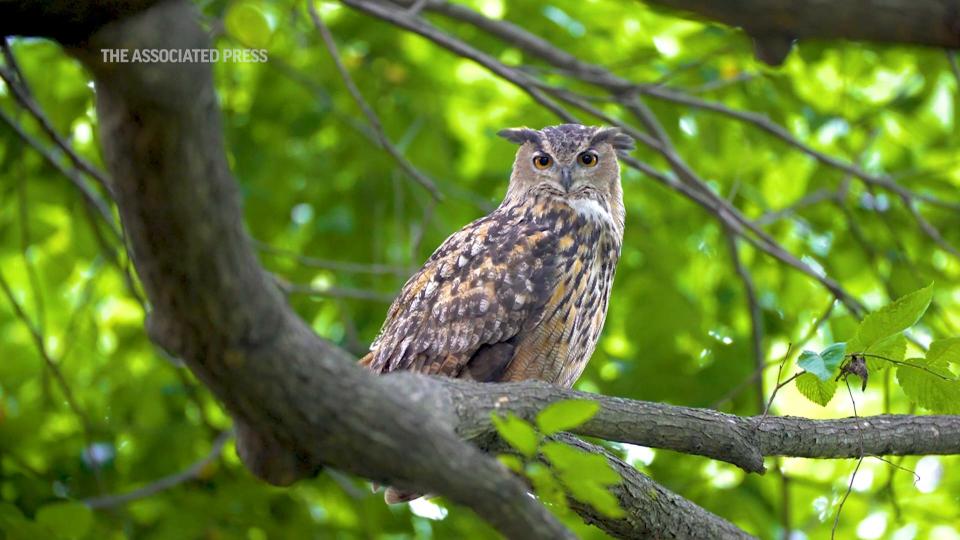Opinion: New York City's Flaco the owl might have died partly by effects of rodenticides
Flaco, the Eurasian eagle-owl (Bubo bubo), born in 2010 at a bird zoo in North Carolina, died on Feb. 23, after striking a building on the Upper West Side of Manhattan.
Flaco, the only free-flying, Eurasian eagle-owl in North America, lived for 12 years in a closet-sized enclosure at the Central Park Zoo until he was released by well-meaning vandals last February.
Eurasian eagle-owls are one of the largest species of owls who range throughout Eurasia. True to his species, Flaco’s distinctive ear tufts and expressive, pumpkin-colored eyes made him a cause célèbre throughout the world with millions rooting for him to survive and thrive as a free bird, which he successfully did for a little more than a year.
When the zoo gave up on recapturing him after Flaco quickly proved his ability to feed himself and his flying swiftly improved after more than a decade of nonflight, concerns remained about the very real possibility that he would accidentally ingest anticoagulant rodenticides used to kill rats, Flaco’s primary food source in the city.
While his necropsy is incomplete, it is likely that Flaco’s impressive flying abilities that had him hooting for hours from the top of his favorite water tower and peeping into sky high windows to the delight of jaded New Yorkers were hindered by the accidental ingestion of rat poison.
No animal should ever suffer from anticoagulant poisoning, but for Flaco, was a shortened life worse than living on his own terms, even in a human-made jungle far from the lands where he should have been born? Would Flaco himself have chosen freedom for one year over a life of up to 40 years locked in an enclosure without a companion and unable to use his flying powers?
World renowned primatologist Jane Goodall called the conditions for animals at Sea World “acoustical hell.” Whales travel up to 100 miles per day yet are trapped in bathtub size tanks for up to 50 years at marine parks. For an owl designed to soar thousands of miles across oceans, isn’t a flightless life in a cage the equivalent of physical and psychological torture regardless of how long that life is?
Animal ethics scholars continue to explore humans’ entangled relationships with other animals, including the labels we give to some animals we cohabitate with and to other animals we justify killing in mass because it’s convenient and expedient for human purposes. Why do cats and dogs live in human dwellings but foxes who giggle when they are tickled are legally caught in steel leghold traps and then torn apart limb by limb while still alive by dogs in North Carolina? Why do so many of you justify and excuse the obvious pathologic, zoochotic behavior (pacing, bobbing, self-mutilation, etc.) exhibited by the mountain lions and other animals trapped in inadequate enclosures at the WNC Nature Center?
As I wrote previously upon the tragic death of world-famous mountain lion, P-22, who survived his initial bout of rodenticide poisoning with quick veterinary treatment, California, where P-22 lived, is the current U.S. leader on wildlife co-existence, connectivity, and research on anticoagulant poisoning. For all the hunters claiming game meat is healthier than farmed animal proteins and to Colleen Olfenbuttel, the N.C. Wildlife Resources Commission’s black bear and furbearer biologist, who boasted about the “591,700 plates of food” produced from the 2022 bear harvest, a 2018 study found “game animals may be exposed to ARs through direct consumption of bait, ingestion of contaminated food or vegetation, or consumption of contaminated prey items” with “the highest prevalence of AR exposure” found in bears who were “most likely to be exposed to brodifacoum, a second generation AR used primarily in and around residences.”
For the nonhunters, rodenticides kill more than rodents; they can kill any animal, including domestic animals and even children who encounter a poisoned animal. The City of Asheville liberally uses rodenticides downtown with no acknowledgment of the harm they cause to wildlife or the little they do to reduce rodent populations. Anticoagulant poisoning can be a slow and extremely painful and terrifying death, and besides the high risk to non-rodents, rodents, who have been observed tidying up for humans, deserve a fast and painless death if they must be killed.
Whatever the cause of Flaco’s death, humans failed him. While millions who admired him mourn, I can only ask his death will spur policy makers to ban poisons that cause so much suffering to other animals and risk to human health and the public begins to reconsider why the torment of other animals for human entertainment or even “education” is an acceptable practice in 2024.
More: Opinion: Famed LA mountain lion P-22's life can teach NC a lot about wildlife management
More: Opinion: Bear hunters, NC Wildlife Commission misleading public on black bear population

Diana Starr, of Asheville, studies the complex entanglements of multispecies relationships around the world and is the founder of Poison Free Asheville.
This article originally appeared on Asheville Citizen Times: Opinion: Flaco the owl's death should hasten ban on poisons

